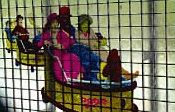Seeing the Light
By Masonry
 When it came time to reconstruct the Stillwell Avenue Terminal in New York City, the Metropolitan Transit Authority (MTA) had several requirements in mind. First, it wanted the reconstruction to have a 50- to 100-year life span. It also wanted the structure to incorporate some green building products and natural aspects with the design. Finally, due to an understanding that incorporating cultural art in public areas causes less vandalism and image problems, it wanted to include an artistic representation of the area.
When it came time to reconstruct the Stillwell Avenue Terminal in New York City, the Metropolitan Transit Authority (MTA) had several requirements in mind. First, it wanted the reconstruction to have a 50- to 100-year life span. It also wanted the structure to incorporate some green building products and natural aspects with the design. Finally, due to an understanding that incorporating cultural art in public areas causes less vandalism and image problems, it wanted to include an artistic representation of the area.
With these requirements, the MTA turned to Glass Block of America, a 20-year-old business headquartered in Medina, Ohio, who proposed a very unusual solution for the MTA's needs.
Glass Block of America made the exterior wall, which is approximately 300 feet long by 17 feet 4 inches high, out of Pittsburgh Corning Corporation's VISTABRIK, solid glass blocks. This in itself is not unusual, as transit projects across the country are utilizing this type of block to bring in natural light. The unusual nature is how the art was integrated.
Famed artist Robert Wilson was commissioned to create a whimsical portrayal of Coney Island, including a 12-foot hotdog with purple mustard, titled "My Coney Island Baby." Glass Block of America then shipped VISTABRIKs that are half as thick as the originals, also known as pavers, to Germany to have this painting added to the face of the pavers.
 "Over in Germany, they have incorporated the art on the face of a paver," says Tony Kava, Vice President of Sales at Glass Block America. "They then laminated another paver to it with a PVB foil, like they use in a windshield of a car when they laminate two pieces of glass together. So now what you have is a three-inch solid piece of glass with art in the center of it, so that people can't scratch it off, they can't get to it."
"Over in Germany, they have incorporated the art on the face of a paver," says Tony Kava, Vice President of Sales at Glass Block America. "They then laminated another paver to it with a PVB foil, like they use in a windshield of a car when they laminate two pieces of glass together. So now what you have is a three-inch solid piece of glass with art in the center of it, so that people can't scratch it off, they can't get to it."
So that the natural light of the project wouldn't be diminished, the German artisans also used a special process to add the colors.
"They used glass melting colors," says Kava. "It's not an ink or a dye, but a material that's basically like a liquid glass. They painted silkscreen images onto the pavers, and then they've baked that in a kiln. If you were to use an ink or a dye, you really wouldn't see light coming through the colors. By using glass melting colors, you are still getting all the light through the block, but you still have brilliant images of colors and very detailed, high-definition artwork."
Having completed two requirements, the third ? creating a 50- to 100-year life span wall with three-inch glass blocks only ? also needed a special solution.
 "We used horizontal reinforcement as most applications do, but we also used vertical reinforcement in order to enable us to incorporate large glass block panels without seeing any type of structural steel and so on," Kava states. "In other words, we didn't want to break up the images by having to put steel in, so we used vertical reinforcing in the mortar joints."
"We used horizontal reinforcement as most applications do, but we also used vertical reinforcement in order to enable us to incorporate large glass block panels without seeing any type of structural steel and so on," Kava states. "In other words, we didn't want to break up the images by having to put steel in, so we used vertical reinforcing in the mortar joints."
Also, to limit the amount of water introduced to the wall during the building process, the Glass Block team suggested the use of Laticrete 3701 for the mortar joints.
"Laticrete 3701 is an acrylic additive that promotes bonding and prohibits moisture penetration," says Kava. "In the masonry business, we all know that the first thing to kill a masonry wall is water and moisture. We have a three-inch solid glass wall that's an exterior wall ? it's a lot more susceptible to damage. If there's any type of moisture penetration within this wall, there isn't going to be a lot holding the wall together anymore."
With every one of their requirements met, the MTA can rest assured that the Stillwell Avenue Terminal's "My Coney Island Baby" will last for generations.
About the Author
Masonry, the official publication of the Mason Contractors Association of America, covers every aspect of the mason contractor profession - equipment and techniques, building codes and standards, business planning, promoting your business, legal issues and more. Read or subscribe to Masonry magazine at www.masonrymagazine.com.


















